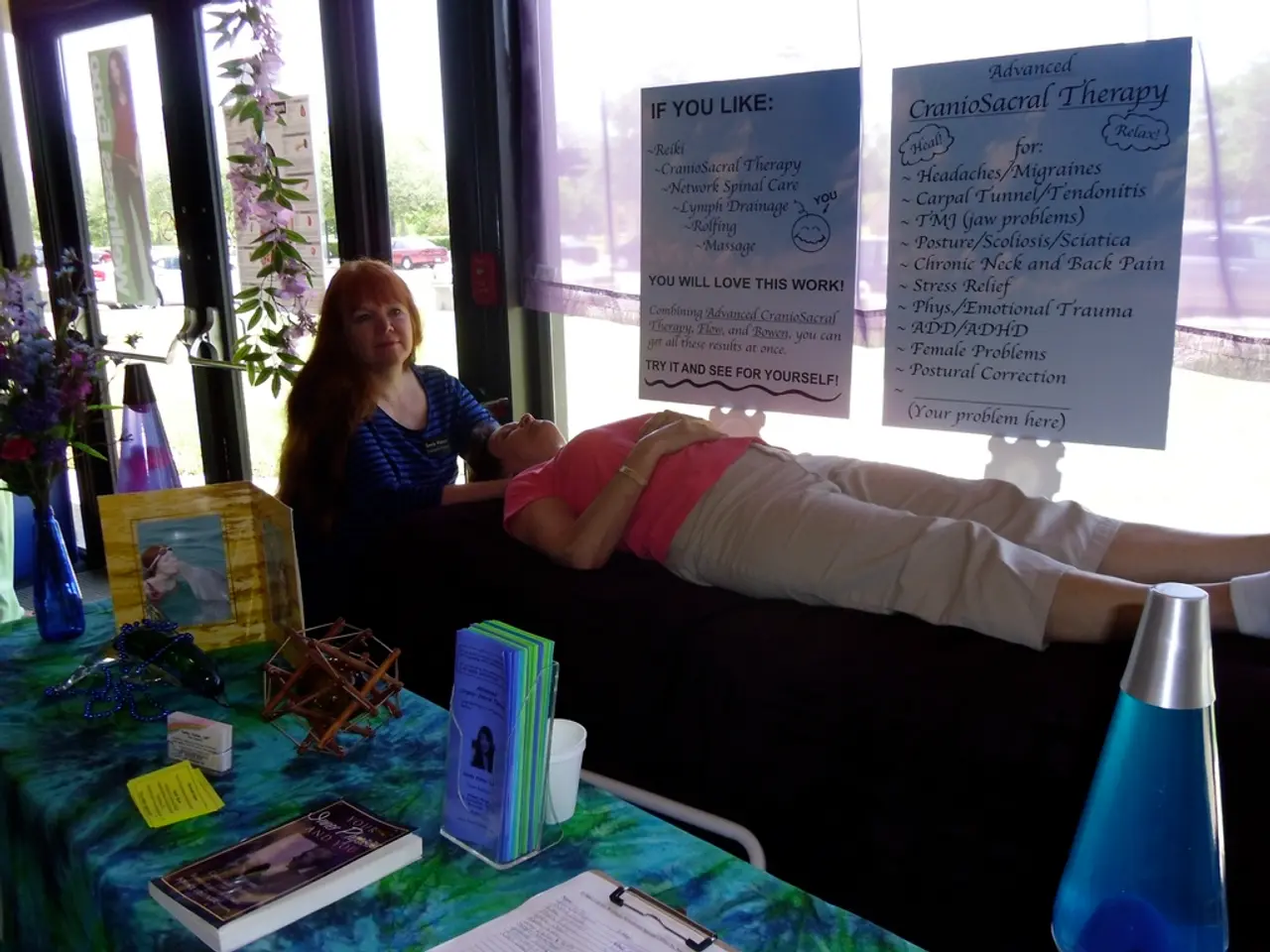Persistent Lower Back Pain: Understanding Root Causes and Potential Remedies
In a recent study involving 192 women aged 18 to 45, approximately 60% reported experiencing dysmenorrhea, or period pain, during their menstrual cycle [1]. This common condition can also lead to lower back pain, a discomfort that affects many women during their periods.
The primary cause of period cramps is the accumulation of chemicals called prostaglandins, which are produced by endometrial cells in the uterus before a period [2]. These chemicals stimulate the uterus to contract strongly, sometimes causing referred pain in the lower back. Lower back pain during menstruation is primarily due to hormonal changes that cause uterine contractions and inflammation [2]. Specifically, the drop in estrogen and progesterone just before and during the period increases prostaglandin production, leading to intensified cramps and back pain. Additionally, increased blood flow (pelvic congestion) can create pressure and discomfort in the lower back region [2].
Several common medical conditions can compound the discomfort associated with lower back pain during menstruation. These include endometriosis, uterine fibroids and cysts, adenomyosis, ovarian cysts, cervical stenosis, pelvic floor muscle tension, pelvic inflammatory disease (PID) and pelvic adhesions [1][2][4].
Endometriosis, for example, involves tissue similar to the uterus lining growing outside the uterus, often on pelvic organs, causing severe pelvic and lower back pain due to inflammation and scarring [1][2][4]. Uterine fibroids and cysts apply pressure on the uterus and surrounding tissues, leading to intensified cramps and back pain [4]. Adenomyosis, a condition where the endometrial tissue grows into the muscular uterine wall, causes inflammation, heavy, and painful periods often accompanied by lower back pain [4]. Ovarian cysts, which are fluid-filled sacs on the ovaries, can increase menstrual cramps and cause pain radiating to the lower back [4]. Cervical stenosis, narrowing of the cervix, can impede menstrual flow, elevating uterine pressure and pain [4]. Pelvic floor muscle tension, tightness or spasms in the pelvic floor muscles during menstruation, can contribute to lower back discomfort [1]. PID and pelvic adhesions also cause pain during periods due to infections and scar tissues from previous inflammation [4].
It's essential to seek medical care for period pain if any accompanying symptoms occur, such as bleeding between periods, pain during sex, or pain in the vagina, or if the pain is new or worsening, so intense that it prevents the person from going to work or school, or if there are other back or muscle symptoms [1]. Hormone therapy, surgery, and in severe cases, removal of the uterus can treat dysmenorrhea [1]. Hormonal birth control pills may help reduce the intensity of period cramps and ease some symptoms of endometriosis [1].
Fortunately, several methods can help alleviate period cramps and lower back pain. Acupuncture, massage, having sex or masturbating, exercise or physical therapy, stretching, practicing relaxation and mindfulness techniques, and taking certain supplements can all provide relief for some people [1][3]. Applying warmth to a painful area with a heating pad or hot water bottle can also help [3]. When dysmenorrhea is secondary, treating the underlying condition can reduce or even eliminate the pain [1].
In conclusion, lower back pain during menstruation is a complex issue that can be caused by a combination of hormonal changes, medical conditions, and poor posture. Understanding these factors is crucial for managing and alleviating the discomfort associated with this condition. If you are experiencing persistent lower back pain during your periods, it is advisable to consult a healthcare professional for a proper diagnosis and treatment plan.
References: [1] Mayo Clinic. (2021). Menstrual cramps: Symptoms and causes.
- Approximately 60% of women aged 18 to 45 reported experiencing menstrual pain, often accompanied by lower back pain, according to a recent study.
- Hormonal changes during menstruation, including a drop in estrogen and progesterone, can increase the production of prostaglandins, leading to intensified period cramps and back pain.
- Endometriosis, a condition where tissue similar to the uterus lining grows outside the uterus, can cause severe pelvic and lower back pain due to inflammation and scarring.
- Uterine fibroids and cysts, adenomyosis, ovarian cysts, cervical stenosis, pelvic floor muscle tension, PID, and pelvic adhesions can all contribute to lower back discomfort during menstruation.
- Severe pelvic and lower back pain may signal underlying medical conditions such as endometriosis, fibroids, or cysts, and seeking medical care is advisable.
- Hormone therapy, surgery, and in severe cases, removal of the uterus can treat dysmenorrhea, while hormonal birth control pills may help reduce the intensity of period cramps and ease some symptoms of endometriosis.
- Acupuncture, massage, exercise, stretching, using warmth, and mindfulness techniques can all help alleviate period cramps and lower back pain in some people.
- Menstrual pain, also known as dysmenorrhea, is a complex issue influenced by hormonal changes, medical conditions, and poor posture, making understanding these factors crucial for managing and alleviating the discomfort.
- Obesity, colitis, HIV, breast cancer, and depression have not been directly linked to menstrual pain or lower back pain during menstruation but are important health-and-wellness and women's health considerations in their own right.
- Science continues to evolve in its understanding of menstrual pain and lower back pain during menstruation, promising potential advancements in diagnosis and treatment for those affected by this condition.




